|
| |
|
All Aboard for Railroad Pocket Watches
by Bob Brooke
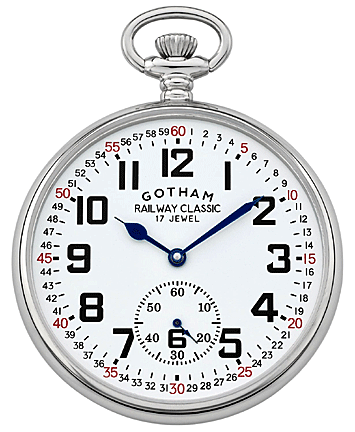 On
April 19, 1891, a train engineer's watch stopped for four minutes and
then started again. This temporary mechanical failure resulted in a
train wreck that killed nine people in Kipton, Ohio. The railroads set
up a commission to create new standards for the railroad pocket watch,
to be used by all railroads. On
April 19, 1891, a train engineer's watch stopped for four minutes and
then started again. This temporary mechanical failure resulted in a
train wreck that killed nine people in Kipton, Ohio. The railroads set
up a commission to create new standards for the railroad pocket watch,
to be used by all railroads.
A railroad grade pocket watch is simply a watch that was approved by a
particular railroad organization for use by engineers and conductors on
their line. But the specific definition of “railroad grade” evolved
quite a bit over the years.
The commission required engineers to have their watches inspected
regularly and to submit a certificate stating its reliability to
supervisors. When there was only one track for trains barreling in both
directions, being on time was a matter of life and death. As the Kipton
wreck proved, an engineer's railroad pocket watch being off by as little
as four minutes could mean disaster.
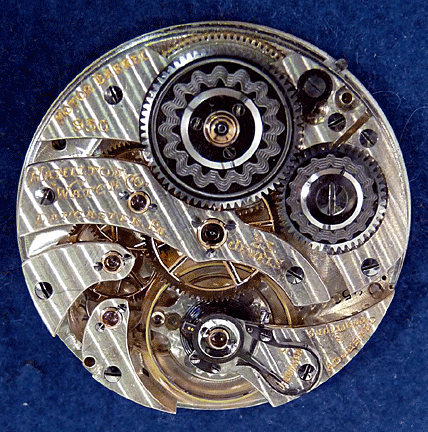 The
new standards dictated that a railroad pocket watch have at least 15
jewels. After 1886, the number of jewels increased. They also had to be
accurate to within 30 seconds per week. They also had to have a white
face, although the railroads allowed silvered faces until around
1910second decade of the 20th century); black Arabic numbers each minute
delineated; size 16 or 18; adjusted to five positions; and temperature
compensated. (Canadian RR watches, on the other hand, had Roman numerals
and an inner ring of Arabic numerals from 13-24 for the p.m. hours.) The
new standards dictated that a railroad pocket watch have at least 15
jewels. After 1886, the number of jewels increased. They also had to be
accurate to within 30 seconds per week. They also had to have a white
face, although the railroads allowed silvered faces until around
1910second decade of the 20th century); black Arabic numbers each minute
delineated; size 16 or 18; adjusted to five positions; and temperature
compensated. (Canadian RR watches, on the other hand, had Roman numerals
and an inner ring of Arabic numerals from 13-24 for the p.m. hours.)
The rules were sometimes broken so you can still find a RR watch with
Roman numerals. The last two requirements were critical. As the early
watchmakers discovered, not only would cold and heat cause the movement
to slow or speed up, but so did the watch's position. Imagine trying to
carry a watch in one position all the time, especially while working on
a train. Railroad watches had to stand up to constant abuse from the
jarring and swaying of early trains.
Pocket watch sizes run from 0 to 23. This doesn’t refer to its width or
length or casing. It’s actually refers to the size of the movement. To
meet railroad requirements, a watch's movement must be a size 16 (1 7/10
inches) or a size 18 (1 23/30inches).
What is a Railroad Pocket Watch?
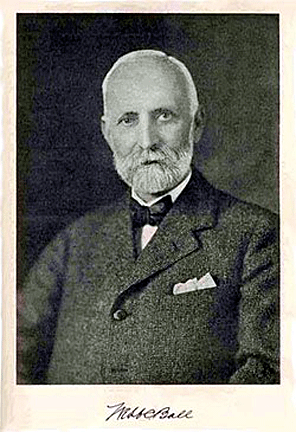 And,
contrary to common belief, there were many regulations in place before
Webb C. Ball was commissioned by railroad officials in the 1890’s to
create an overarching set of railroad watch qualifiers. And,
contrary to common belief, there were many regulations in place before
Webb C. Ball was commissioned by railroad officials in the 1890’s to
create an overarching set of railroad watch qualifiers.
Before the 1890’s, and until the entire railroad industry accepted
Ball’s standards, different railroads had different qualifiers. One line
may have had a list of accepted makes and models while another may have
only listed necessary features or timekeeping performance thresholds.
This makes evaluating older watches as railroad grade a difficult task,
because a watch may have met the standards of one company but not
another.
As the rail industry grew in the United States, the number of active
trains grew with it. In order to use the track efficiently, companies
needed to create time schedules identifying when each section of the
track was safe to use. The timekeeping accuracy of the engineer’s and
conductor’s watches was crucial if two trains were moving in opposite
directions. If one of the two engineers’ or conductors’ watches were
keeping bad time there was a strong likelihood of a collision. Railroad
watches became known as “standard” watches because they met the
railroad’s standards of timekeeping.
What were the most common features of
railroad watches?
The “best” railroad watches were made after 1900. At this time both the
watch companies and the railroads were hitting their stride in terms of
volume and quality. An important part of standard watch regulations
included service intervals and testing, but there’s also a list of
features that almost all railroad watches shared.
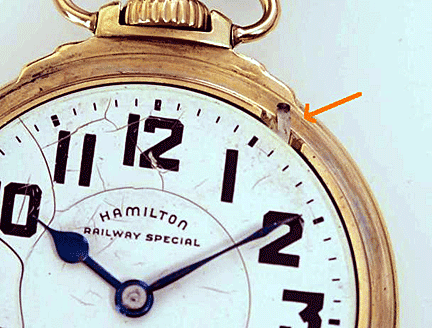 The
most prominent feature of 1900’s railroad watches was their lever
actuated setting mechanisms–commonly referred to as "lever-set.". Most
watches were put in time-setting mode by pulling the crown, or winding
knob, away from the watch, then pushing the crown back towards the watch
to return to winding mode—referred to as "pendant-set." The
most prominent feature of 1900’s railroad watches was their lever
actuated setting mechanisms–commonly referred to as "lever-set.". Most
watches were put in time-setting mode by pulling the crown, or winding
knob, away from the watch, then pushing the crown back towards the watch
to return to winding mode—referred to as "pendant-set."
A lever-set mechanism required the user to remove the bezel of the watch
and engage a lever to place the watch in setting mode. This tedious
process of removing the bezel had a very important purpose; it ensured
that the time on the watch was never accidentally changed by catching
the winding knob on a pocket or any number of other unintentional
situations.
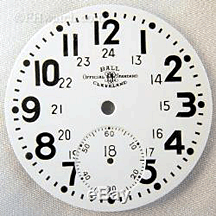 Another
iconic feature of railroad watches was their big, bold, black, Arabic
numerals on highly contrasting white enamel dials with large bold hands.
This feature made telling the time as clear and easy as possible while
creating a distinctive and functional railroad watch design. Another
iconic feature of railroad watches was their big, bold, black, Arabic
numerals on highly contrasting white enamel dials with large bold hands.
This feature made telling the time as clear and easy as possible while
creating a distinctive and functional railroad watch design.
Mechanically speaking, almost all 1900’s railroad watches shared a
number of performance and reliability enhancing features. Most had a
fixed regulator to avoid timekeeping variation from impact, a double
roller balance wheel to avoid going out of action, 19 or more jewels to
reduce friction and increase consistency of the gear train, timekeeping
adjustment in five or more positions to make sure the watch kept
accurate time regardless of its orientation, and adjustment for
temperature to ensure accuracy in a variety of climates. Many railroad
watches had solid gold or gold
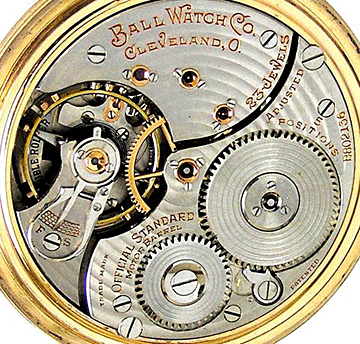 plated
gear trains and jewel settings to reduce the effects of magnetism as
well as reduce tarnishing, and later watches had features such as
magnetically resistant balance wheels. plated
gear trains and jewel settings to reduce the effects of magnetism as
well as reduce tarnishing, and later watches had features such as
magnetically resistant balance wheels.
Some of the highest end railroad watches featured what was referred to
as an up-down wind indicator. It visually communicates how much wind
remains in the watch on a sub-dial at 12 o’clock. This feature didn’t
necessarily improve the timekeeping performance of the watch, but it was
convenient for railroad workers to be aware of how much wind was left on
the watch to avoid letting the watch run out.
Why do railroad watches appeal to
collectors?
The Railroad Pocket Watch is particularly appealing to collectors
because of the quality of its workmanship, second only to chronometers.
Waltham and Elgin made the most, followed by Hamilton. Plus
manufacturers didn’t produce these watches in the same quantities as
everyday pocket watches.
The spirit of the rails inspires both watch and railroad memorabilia
collectors to collect railroad watches. And these watches are
affordable, with a typical watch in fine condition selling for between
$300 and $600.
< Back to Collecting Archives
Next Article > |
|

|
|
FOLLOW MY WEEKLY BLOG
Antiques Q&A
JOIN MY COLLECTION
Antiques and More
on Facebook
LIKE MY FACEBOOK PAGE
The Antiques
Almanac on Facebook |
|
No antiques or collectibles
are sold on this site.
|
|
How to Recognize and
Refinish Antiques for Pleasure and Profit
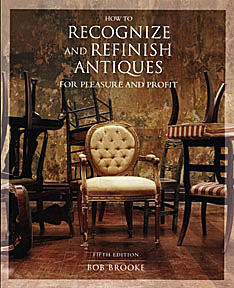
Have
you ever bought an antique or collectible that was less than perfect and
needed some TLC? Bob's new book offers tips and step-by- step
instructions for simple maintenance and restoration of common antiques.
Read an
Excerpt
|
|

|
|
|
|
|
